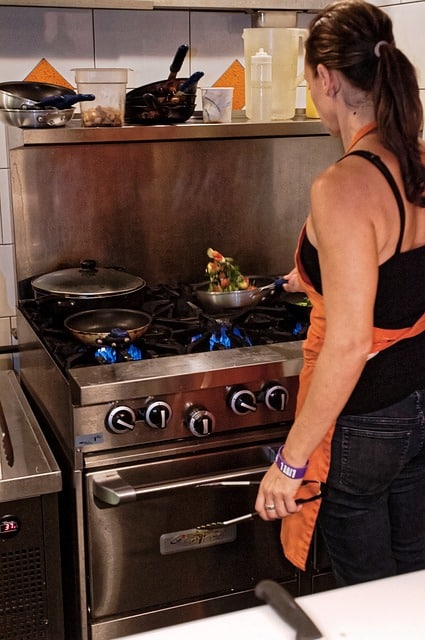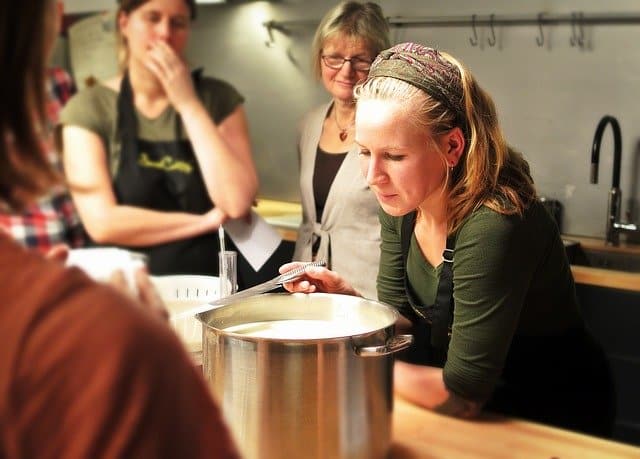Contrary to popular belief, a community kitchen isn’t just a soup kitchen. Nor is it simply a general space meant to serve up large quantities of food for charity, fundraisers, or other events.
Of course, these two definitions do apply to community kitchens – but there is a larger overlap between soup kitchens, community kitchens, and other similar kinds of facilities. The reality is that a “community kitchen” is actually a broader term that includes all the other definitions. Not only that, but it can be super beneficial in enhancing the success of your homestead.

What are Community Kitchens?
A community kitchen, also known as a collective kitchen, is a community-based program in which small groups of people come together. This can either be all at once or individually over a period of time, to prepare meals.
These meals can be:
- Taken home to feed a family
- Donated to a community (as with a soup kitchen)
- Sold for profit
These kitchens can either be formal or informal. They can be used to support and strengthen the local community, or they can support your own small business.
The essential idea behind a community kitchen is that it is a shared space in which people can prepare food. That’s the loose concept, anyway. In reality, a community kitchen can have many set-ups.
A community kitchen can be set-up in a church basement, a shared space in someone’s house, or a separate rented facility. Often, community kitchens are leased and the fees for leasing or renting, cleaning, and general maintenance are shared amongst all members.
Benefits of Community Kitchens for Homesteads
1. Promotes Use of Local Ingredients

One of the benefits of community kitchens – at least for people with gardens or farms – is that learning how to cook naturally goes hand-in-hand with the local food movement.
It is beneficial to any community, for instance, when tomato sauce is made out of locally-grown heirloom tomatoes, especially when they’re in season and at the peak of freshness.
People usually join these kitchens because they have a deep desire to learn and experience cooking at its finest, as a result, there’s a greater likelihood of local foods being integrated into the menu.
2. Allows One to Sell Canned and Homemade Food to Others
One of the many important reasons for joining or starting a community kitchen (for many homesteaders and farmers) is the ability to process food in a way that is safe and legal for sale.
Do you want to sell your Grandma’s famous homemade dill pickles at the farmer’s market? That’s a great idea but unfortunately, for you to do so legally in the US, you need to prepare the pickles in a USDA-inspected kitchen.
The likelihood of getting your home kitchen approved by these rigorous standards is slim and it’s inconvenient. Having a separate facility is ideal, but it’s going to be costly. And really, how many times will you actually use it?
That’s where the beauty of a community kitchen lies. Multiple members can chip in to create a shared space that’s safe and legal to use. A community kitchen could also be used by caterers who need space to prepare food but don’t want to use their own facilities.
3. Affordable and Low-Maintenance
As a corollary to the point above, a community kitchen is an affordable and low-maintenance way to get started with running your own business.
You will be chipping in on all costs and maintenance fees with other members. Plus, you can also save money by learning cost-effective cooking skills from other members, too.
If you’re a true culinary novice, joining a community kitchen will give you the opportunity to learn more about meal planning, shopping, budgeting, and even reading food labels.
4. Provides an Opportunity for Teaching – Formal and Informal

If you’ve ever wanted to teach cooking classes, a community kitchen is a perfect platform. You won’t have to invite people into your home for classes. Therefore, you’ll have a more neutral atmosphere that will make everybody feel more comfortable.
5. Increases Community Involvement
If you’re familiar with the concept of a community garden, know that a community kitchen works in a similar fashion. It makes it possible for you to interact with new members of your community, potentially those you have never met before.
Not only can you cook in a social atmosphere and build new, long-lasting friendships, but you can get your community involved in a local food movement, too.
Plus, when you start cooking with others, you’ll learn (if you don’t know already) how to prepare delicious and nutritious meals, even when you’re on a budget.
You will be able to discover new flavors that you might not have had the skills to prepare when you were cooking by yourself.
How to Start a Community Kitchen
Interested in starting a community kitchen in your town? That’s a great goal. You’ll need to work through some logistics. Once you do, you’ll be able to set up an affordable, high-quality environment for everyone.
1. Commercial vs. Non-Commercial Community Kitchens

If you’re trying to figure out the difference between soup kitchens and other kinds of community kitchens, it’s relatively simple.
Soup kitchens – along with other kinds of kitchens that you might find, such as those run from church halls – are usually considered non-commercial kitchens.
These kitchens are typically owned by a non-profit organization (like a church or educational authority.) For one, they can be signed out for use by community members.
They may or may not have all the equipment and space you need. They also may or may not be inspected (in the case of churches, they often aren’t).
A commercial kitchen is one that is designed specifically for food entrepreneurs wanting to start up or grow a food business. They usually charge members a monthly rate for rental fees or can charge one-time hourly rates, too.
2. Decide on Fees

If you decide that a commercial kitchen is right for you, decide how you are going to charge your members. If you already know several people who want to go in on the community kitchen idea with you, it will best to split the costs evenly amongst your members.
That way, you won’t have to worry about signing the kitchen out for rentals to people you don’t know. You also won’t have to worry about coming up with contracts for the use, which can be time-consuming.
However, if you plan on renting out the kitchen for community events or even once-off use, you will need to decide how you will sign people up and charge them.
You could do a combination of hourly rates, monthly leases, security deposits, and more. Most commercial kitchens charge up to $20 per hour. This can vary depending on how many hours you rent each month.
3. Will You Need Employees or Volunteers?
Next, decide who will be needed to manage the kitchen. If you’re running a non-profit community kitchen (like one ran from a church or school) you’ll probably be able to use volunteers. However, if you’re going to run a commercial kitchen and plan on having lots of people coming in and out, you might want to add employees to the roster, too.
If you’re going to be offering educational programs or classes, don’t forget to factor in professionals as well.
4. Figure Out Who’s Interested

Assuming that you’re going to do this on your own and don’t already have a group of people with whom you can start up your community kitchen, you’ll need to put some feelers out there.
Is a community kitchen in demand in your neighborhood? Does your community already have a shared space or kitchen area? How well-utilized is it? If you plan on charging people to use your community kitchen, you need to have an idea of the demand.
Even if you don’t plan to charge, getting an idea of who is interested can help you figure out how much space you need. It can also help you plan your funding. If you plan on operating a non-profit community kitchen, you might be able to apply for grants to help you get started.
You will also need a rough idea of numbers so you can stock your kitchen with cooking supplies! You may be able to get some people to bring these with them. Some organizations might be willing to donate, too, depending on the specific structure of your community kitchen.
How Will You Advertise Your Community Kitchen?

Now that your community kitchen is up and running, it’s time to get the word out! Usually, the audience for community commercial kitchens is entrepreneur food producers. These are people who intend to sell their food at food stands or farmer’s markets.
So getting in touch with your local chamber of commerce can be helpful. You can also advertise on social media and use the free marketing tools there to spread the word.
Ultimately, a community kitchen can serve several purposes – no two kitchens are quite alike. There are plenty of ways that you can use a community kitchen to help build relationships in your neighborhood. It’s up to you to find ways that work best for you.












